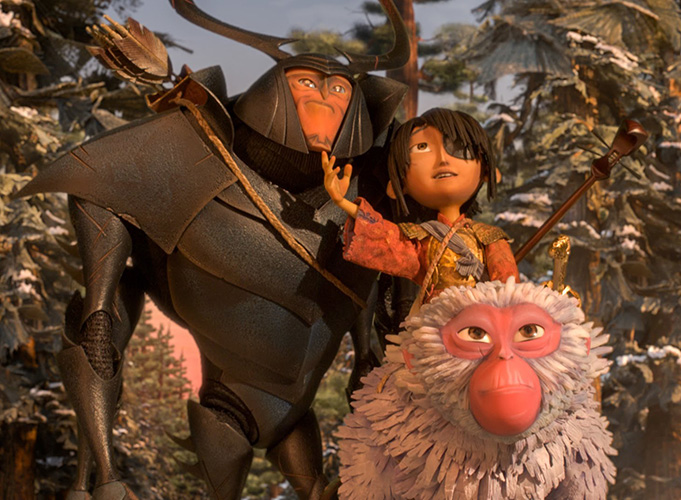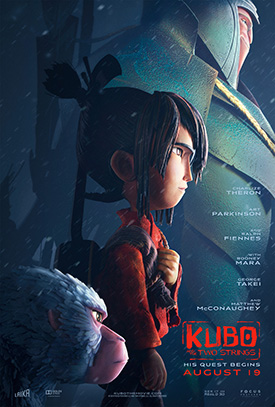Kubo Will Tug At More Than Two of Your Heartstrings

Whenever I screen a new movie, I do my best to a write balanced, objective review. Sometimes, though, objectivity and analysis can’t compete with the sheer joy and delight on screen.
Kubo and the Two Strings is one of those rare films that reminds me how wonderful, magical, and transporting a movie can be, of being 10 years old and watching a Disney movie for the first time. That a movie can be emotional without being sappy, action-packed without being frenetic or distracting. And that when done well, stop-motion animated films can tell compelling stories through incredibly captivating visuals.
Kubo is done very, very well.
 Made with deep affection for its characters, its actors and its audience, Kubo and the Two Strings is simple but not simplistic. Kubo, voiced by Art Parkinson (best known as Rickon Stark in Game of Thrones), is a young villager in a stylized feudal Japan who spins fantastical tales of samurai fighting mythical monsters. Using his voice and his shamisen (a traditional Japanese three-stringed lute), Kubo enchants colored paper to leap from his pack and transforms into origami, coming to life in the form of the samurai, animals and monsters in his magical story.
Made with deep affection for its characters, its actors and its audience, Kubo and the Two Strings is simple but not simplistic. Kubo, voiced by Art Parkinson (best known as Rickon Stark in Game of Thrones), is a young villager in a stylized feudal Japan who spins fantastical tales of samurai fighting mythical monsters. Using his voice and his shamisen (a traditional Japanese three-stringed lute), Kubo enchants colored paper to leap from his pack and transforms into origami, coming to life in the form of the samurai, animals and monsters in his magical story.
When Kubo accidentally stays out past sundown, his vengeful aunts locate him and reveal their murderous intent. Only a great sacrifice by his sick mother enables him to escape. When he wakes up, his sole companion is Monkey. Still channeling Furiosa, Charlize Theron makes Monkey the quintessential tough, protective companion. They set off to find the fabled sword, armor and helmet that can protect him from his aunts and his grandfather, the Moon King (Ralph Fiennes, similarly channeling Voldemort). Along the way, Kubo and Monkey meet Beetle, a 4-armed and armored samurai bug with no memory. Voiced for goofy laughs by Matthew McConaughey, Beetle is a somewhat stock character: the loveable, fiercely protective sidekick, amusing if heavy on the slapstick. By the end of his quest, Kubo has learned valuable lessons about himself, family and sacrifice, as well as the significance of the titular two strings.
Every frame is filled with visual spectacle. The 3D is fairly restrained and used quite effectively. Fans of Laika films will instantly recognize the production design and visual aesthetic, strongly reminiscent of their work on Corpse Bride, The Boxtrolls, and especially Coraline. First-time director Travis Knight, a lead animator on the above-mentioned movies, doesn’t have quite the same gift for storytelling or sure hand as Coraline’s Harry Selick, but he delivers a consistent, stunning movie.
Monkey is one of the most entertaining, fully realized characters in any recent animated film. Theron infuses her with wit, charm and a ferocious maternal nature. And her snow monkey fur is a wonder, thousands of felt strips in constant motion. I boggled at the amount of loving effort it took to animate each piece by hand. Oh, and there’s a dragon; it’s visually breathtaking, highly imaginative, and its aerial combat defies my understanding of how a stop-motion creation moves through space so seamlessly.
Stellar stop motion work
The stop-motion animation of characters, creatures and sets is stunningly fluid. If anything, it’s almost too smooth; the absence of typical stop-motion jerkiness takes away some of the rough charm of older, less fluid movies like Nightmare Before Christmas. Fortunately, the closing credits includes a short behind-the-scenes look at how the giant mechanical skeleton from an early scene is manipulated by hydraulic actuators and a team of filmmakers. It’s a welcome reminder that Kubo was made using old-school practical effects, immense imagination and vision, and countless hours of painstaking work, aided by computers rather than made by them.
The score was wonderful. As a musician, I loved that the shamisen was an integral part of both the soundtrack and the story, the focus of Kubo’s magic that played a bittersweet note near the end. It would have been even more effective if the score had let the shamisen stand out more while Kubo was playing; it was occasionally lost under the swell of the orchestra. And two big thumbs up for Regina Spektor’s brilliant, Japanese-tinged cover of “While My Guitar Gently Weeps,” wisely deployed only for the closing credits.
Is the story a little predictable? At times. Are some of the characters a bit thin? Sure. Does it matter? Not in the least. The movie is far greater, and more gorgeous, than the sum of its parts. Kubo is easily one of the best movies I’ve seen in some time.
Watching Kubo reminded me of how few truly beautiful, deeply imaginative movies are being made. Movies like Kubo are increasingly rare. They are expensive and time-consuming to make. They lack the built-in appeal of a sequel, of a superhero movie, of a well-known story adaption. Add in a limited ad campaign and little word of mouth, and Kubo is unlikely to earn summer-blockbuster money, which makes it harder for filmmakers to make movies like this. If you love creative and imaginative film and the sheer joy of watching a movie that makes you feel like a kid again, please see Kubo and the Two Strings. I think you’ll love it. And as soon as it opens, I will gladly pay to see it again.
Kubo and the Two Strings (Laika Entertainment – PG) Grade: A-



